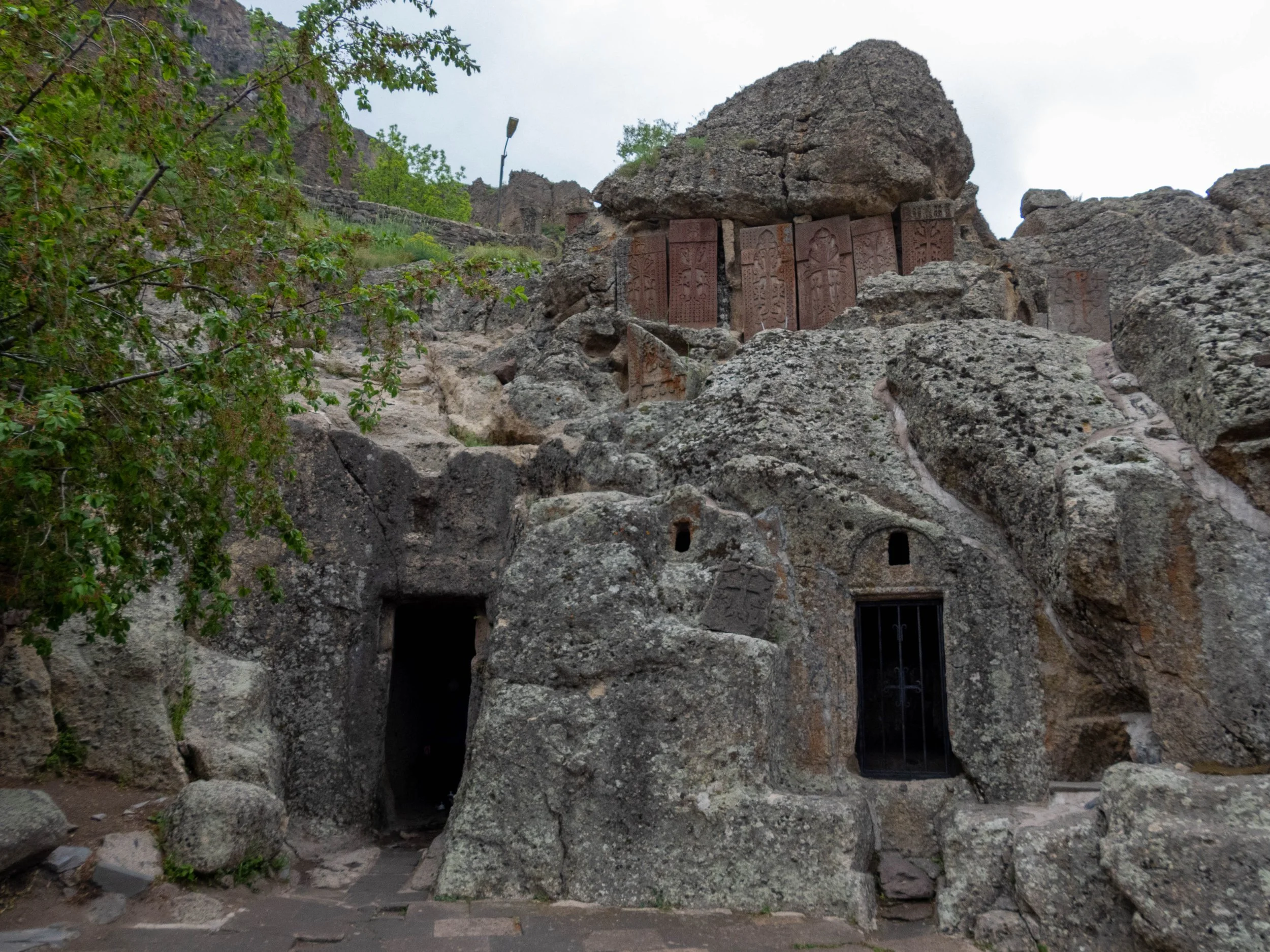This being our final day in Armenia and with so much to see in and around Yerevan, it was undoubtedly going to be a busy day.
We departed Yerevan quite early and drove for about an hour to the Kotayk Province, heading south-east towards the village of Garni.
We thus arrived at a destination referred to as the ‘Symphony of Stones’.
We walked down a concrete pathway for about 500m and the sight above us was indescribably magnificent.
Group walking up path, Symphony of Stones, Garni Gorge
The near vertical rocky cliff above the road is comprised of thousands of hexagonal basalt columns, creating the impression of a cathedral organ with its many pipes. The scene was breathtaking and our group was mesmerised by this extraordinary geological formation. We took many photos although they probably don’t do justice in terms of the splendour we’d experienced.
Hexagonal basalt columns,Symphony of Stones, Garni Gorge
Hexagonal basalt columns,Symphony of Stones, Garni Gorge
Symphony of Stones, Garni Gorge
Symphony of Stones, Garni Gorge
Fish (Sturgeon?) in pond, Symphony of Stones, Garni Gorge
With a certain amount of regret we had to move on, and our next destination was the Geghard Monastery. Some of us were inclined to think “what… another monastery?!” but this proved to be unexpectedly different and interesting. Geghard is the Armenian for lance or spear, and the monastery supposedly had in its keeping, in earlier times the lance that a Roman soldier used to pierce Christ’s side during the crucifixion.
Cave monastery of Geghard, Kotayk Province
This 12th century cave monastery is carved out of a basalt hillside alongside the Amat River. The Geghard Monastery is somewhat similar in its structural origins to the Lalibela churches we’d visited in Ethiopia in 2014. The very large Armenian excavated cave church extends back into the mountainside a considerable distance with several small chapels attached to the main monastery. One chapel we were able to access was at the end of dark stone tunnel barely high enough to stand up in.
Cave monastery of Geghard, Kotayk Province
Dome inside Cave monastery of Geghard, Kotayk Province
We turned the corner at the end of the tunnel and there in semi darkness were five women singing. They were wearing priestess type clothing and their singing was absolutely hypnotic. The divine voices were harmonically toned to perfection and the sounds produced reminded one of Gregorian Chanting. We stayed and listened to this brilliant madrigal group until our time limit meant we had to move on.
Choir inside Cave monastery of Geghard, Kotayk Province
Quite nearby is the Garni Temple. This pagan temple was built in the 1st century AD by Armenian King Trdat I. The temple has a Hellenistic style similar to the Parthenon and sits on a prominent ridge overlooking the Azat River. It was dedicated to the sun god Mitra.
Garni Temple, Garni,
Garni Temple, Garni,
Symphony of Rocks where we had walked earlier in the morning from Garni Temple
Garni Temple (Pagan Temple) from Symphony of Stones, Garni Gorge
The temple was largely destroyed by an earthquake in 1679 but then rebuilt from the rubble in the 1970s although a number of replacement stone sections had to be used, especially in the Ionic columns.
For a late morning tea break we visited a private home and watched two local women make traditional Armenian flatbread “Lavash”. The dough was rolled to a very thin flat sheet and then laid on a cushion where is was spread out to cover the cushion. One of the women with adept skill, then quickly thrust the cushion with its dough layer against the side of the tandoori oven. It stuck to the side of the stone oven and within a minute, the flatbread was ready for eating and it was tasty. Cheese and spring onions were used to add to the flavour.
Women baking traditional Armenian flatbread “Lavash” in Tandoori oven, Garni Village
Women baking traditional Armenian flatbread “Lavash” in Tandoori oven, Garni Village
By early afternoon we were back in Yerevan and ready to spend some time viewing the more prominent buildings in the city.
We drove to the Republic Square and took photos of the National Gallery with the fountain in front and the square surrounded by a number of impressive buildings.
National Gallery, Republic Square, Yerevan
We then moved on to the Armenian Genocide Memorial.
Armenia has suffered war for centuries as its position, wedged between Russia, Turkey, Iran and Azerbaijan has meant ongoing battles over territory and religion. This prolonged conflict over the last two millenia has seen Armenia losing about two thirds of the land area it once possessed in the first few centuries AD. The present day situation is such that two thirds of the total former Armenian population no longer live in Armenia. Very large and ethnically significant numbers of Armenians now live in the regions of north-eastern Turkey and northern Iran (formerly Persia) that had been lost by Armenia through wars.
The Turks in the late 19th century were determined to take greater possession of Western Armenia and set out with the intention of doing this by stealth. Ottoman power and Islam were pressed upon on the Christian Armenians which inevitably led to breaking point. This culminated in 1915 with Turkish Revolutionaries invading Armenia and an estimated two million Armenians were murdered in this act of barbaric genocide.
The Genocide Museum and Memorial pay homage to those millions who died in this terrible saga, which to this day is claimed to have “never occurred” by some countries that politically support Turkey.
Genocide Memorial, Yerevan
Genocide Memorial, Yerevan
Genocide Memorial, Yerevan, Armenia, 20 May 2023
We finished the day with a visit to the Matenadaran Institute of Ancient Manuscripts. We viewed a vast array of documents and manuscripts supposedly making this museum one of the richest repositories of such manuscripts and ancient books in the world.
Anatomical manuscript in Matenadaran Institute of Ancient Manuscripts, Yerevan
Arabic manuscript in Matenadaran Institute of Ancient Manuscripts, Yerevan
On exiting the Matenadaran Institute we were delighted to find the rain had stopped and there, in the southern distance about 30km away was the massive snow covered peak of Mt Ararat. Mt Ararat has two prominent peaks and the one we saw yesterday through misty rain was Little Ararat (3925m), The peak we were looking at now was the high peak (5137m). It looked magnificent and dominated the horizon despite being so far away.
Mt Ararat (5137m) from Yerevan
On our return to our hotel we passed the impressive Armenian Parliament House and the Opera House but time was not sufficient to do much more.
We had a quick meal and headed back to pack and prepare for tomorrow’s 04:45 flight to Austria.























